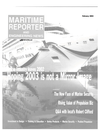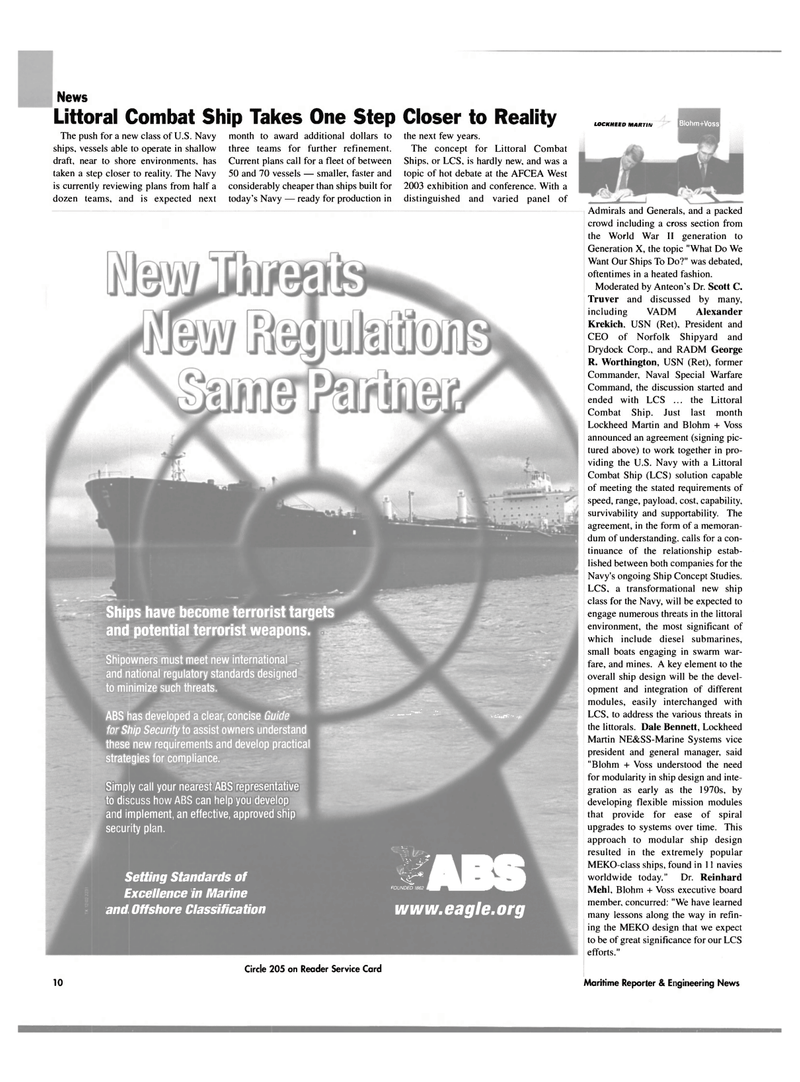
Page 10: of Maritime Reporter Magazine (February 2003)
Read this page in Pdf, Flash or Html5 edition of February 2003 Maritime Reporter Magazine
News
Littoral Combat Ship Takes One Step Closer to Reality
The push for a new class of U.S. Navy ships, vessels able to operate in shallow draft, near to shore environments, has taken a step closer to reality. The Navy is currently reviewing plans from half a dozen teams, and is expected next month to award additional dollars to three teams for further refinement.
Current plans call for a fleet of between 50 and 70 vessels — smaller, faster and considerably cheaper than ships built for today's Navy — ready for production in the next few years.
The concept for Littoral Combat
Ships, or LCS, is hardly new, and was a topic of hot debate at the AFCEA West 2003 exhibition and conference. With a distinguished and varied panel of
Ships have become terrorist targets and potential terrorist weapons. •
Shipowners must meet new international . and national regulatory standards designed to minimize such threats.
ABS has developed a clear, concise Guide for Ship Security to assist owners understand these new requirements and develop practical strategies for compliance. .. . ' " 'Si '•IffrfS - 5jp
Simply call your nearest ABS representative to discuss how ABS can help you develop and implement, an effective, approved ship security plan.
Setting Standards of
Excellence in Marine and Offshore Classification 3 J • T ABS www.eagle.org vC*
FOUNDED 1862
Circle 205 on Reader Service Card
LOCKHEED MARTIN Blohm+Voss 10
Admirals and Generals, and a packed crowd including a cross section from the World War II generation to
Generation X, the topic "What Do We
Want Our Ships To Do?" was debated, oftentimes in a heated fashion.
Moderated by Anteon's Dr. Scott C.
Truver and discussed by many, including VADM Alexander
Krekich. USN (Ret), President and
CEO of Norfolk Shipyard and
Drydock Corp., and RADM George
R. Worthington, USN (Ret), former
Commander, Naval Special Warfare
Command, the discussion started and ended with LCS ... the Littoral
Combat Ship. Just last month
Lockheed Martin and Blohm + Voss announced an agreement (signing pic- tured above) to work together in pro- viding the U.S. Navy with a Littoral
Combat Ship (LCS) solution capable of meeting the stated requirements of speed, range, payload, cost, capability, survivability and supportability. The agreement, in the form of a memoran- dum of understanding, calls for a con- tinuance of the relationship estab- lished between both companies for the
Navy's ongoing Ship Concept Studies.
LCS, a transformational new ship class for the Navy, will be expected to engage numerous threats in the littoral environment, the most significant of which include diesel submarines, small boats engaging in swarm war- fare, and mines. A key element to the overall ship design will be the devel- opment and integration of different modules, easily interchanged with
LCS, to address the various threats in the littorals. Dale Bennett, Lockheed
Martin NE&SS-Marine Systems vice president and general manager, said "Blohm + Voss understood the need for modularity in ship design and inte- gration as early as the 1970s, by developing flexible mission modules that provide for ease of spiral upgrades to systems over time. This approach to modular ship design resulted in the extremely popular
MEKO-class ships, found in 11 navies worldwide today." Dr. Reinhard
Mehl, Blohm + Voss executive board member, concurred: "We have learned many lessons along the way in refin- ing the MEKO design that we expect to be of great significance for our LCS efforts."
Maritime Reporter & Engineering News

 9
9

 11
11
